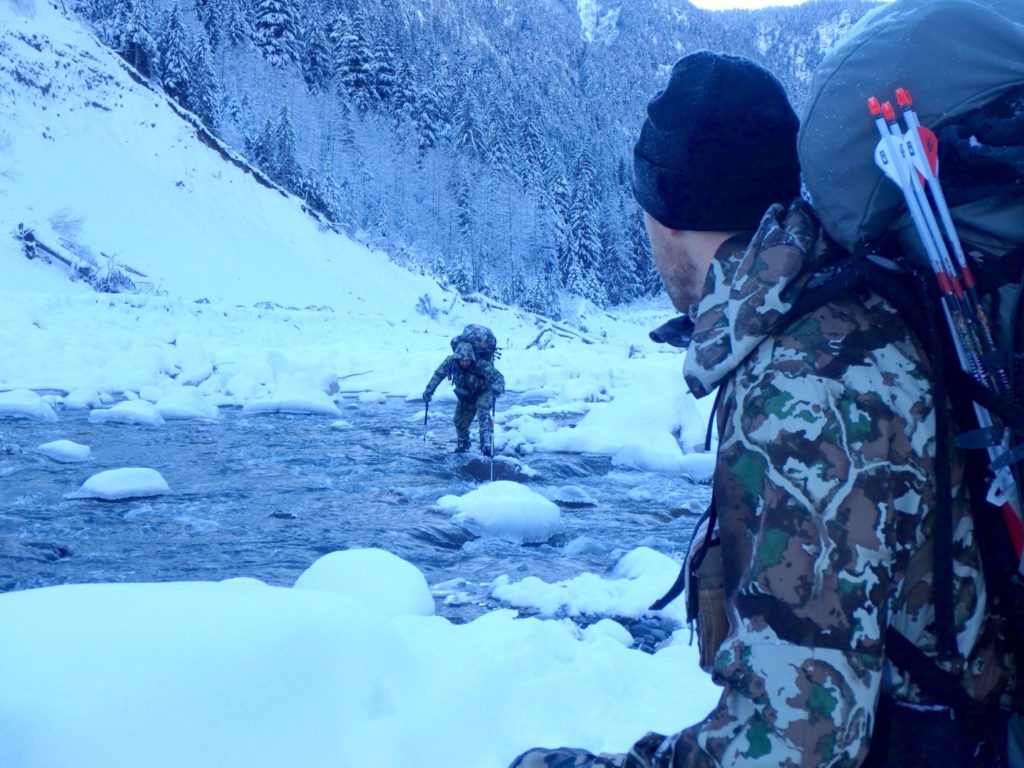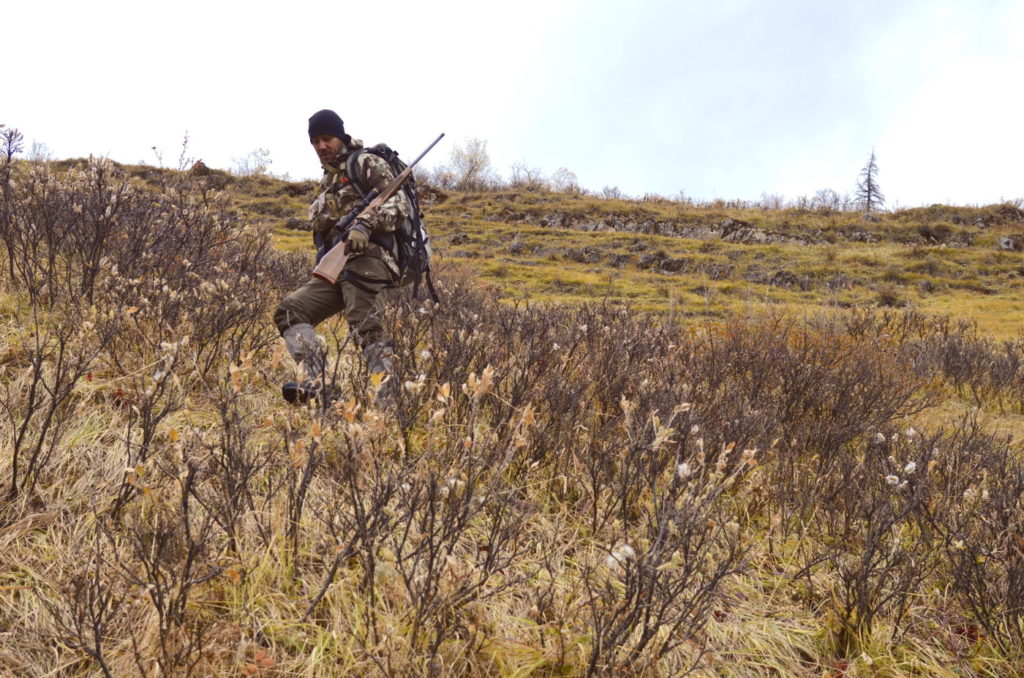If you’re reading this and headed North of the 60th parallel in the coming weeks I wish you the best of luck. For you, this month’s Mountain Fitness article will hopefully be confirmation of a job well done in terms of your hunt preparation. On the other hand, if you read this and are left thinking, “Oh shit”, then you may be in for one hell of a learning experience. A lesson you’ll likely never forget.
If like me your hunt plans don’t have you leaving home for another 4 weeks or more, this article will cover one of the most important components of your physical hunt preparation: proving your fitness under real world conditions. What I’ll call a “stress test” for the balance of this article. As we’ve written here more times than I can count, the most sophisticated program in the world means squat if it doesn’t translate into results in the mountains. With this in mind, it is imperative to test your mountain capabilities at varying points in the year in advance of your actual hunt so you can adjust your program if necessary. Odds are, an appropriate stress test will expose a gap in your fitness or at a minimum solidify the areas (cardio, strength, pack tolerance) you should focus on in the remaining weeks before your actual hunt.
What do I mean by “real world conditions”? In truth, defining exactly what that means for you is the single most important step in designing an appropriate and valuable stress test. The timing, location, duration, and style of the hunt are integral details that go into planning this. If you cut corners you will not get the feedback you’re looking for here.
Are you planning an early season or late season hunt? Will you be contending with extreme heat or cold? Will this be a true backpack hunt or will you be returning to a well-established basecamp every night? Do you have horses? Will your hunts be a compilation of numerous long weekends less than 5 days in duration or are you planning an extended endeavour that will have you in the backcountry for 7 – 14 days straight, sleeping on the ground every night? I could go on.
Going for a slightly tougher or longer hike or loading up your pack a little more than usual is not what I’m suggesting here. What I’m proposing is the kind of testing scenario that takes you into a legitimate overload situation. To be clear this is NOT something you would do on a regular basis as it does increase the chance of an overuse injury. That said, if this form of stress test were to result in some form of mild musculoskeletal injury and you’ve attempted this at least 4 – 6 weeks out from your planned hunt then you’ve actually completed a successful stress-test. That’s right, a mild injury would be a success in this context. It’s preferable to identify these issues ahead of time as opposed to on the hunt itself.
Remember, the whole point of this process is to gather information so you can make adjustments or adaptations to your program if the outcome of the stress test suggests as much. If you put yourself in a true overload situation and you come out with a mild injury what do you think would have happened in the backcountry? However, this is not something to do if you’re currently injured.
So what is an overload? This should be something that represents a BIG jump in duration (time on feet), intensity (grade/elevation), or load (pack weight). I normally try for at least a 50% jump in one or two of those variables when I do a stress test. For example, if your current long hike is 2 hours, try for 3 on your next outing. Or if you’ve been hiking for 2 hours with a 30 lb pack, make it 60 lbs for the same duration. You get the point. I would not bump up all three variables by 50% however, that’s asking for an overuse injury. I don’t mind flirting with the limits but there’s a difference between tough and dumb.
The ideal stress test would of course be something as close to hunt conditions as possible. An overnight camp-out or scouting mission would be at the top of the list in my opinion. But rather than strip your pack down to suit the fact it’s an overnighter, load up to near maximum expected trip weight.
I know this may sound counterintuitive. The cardinal rule in most training situations is to make small increases in the load, intensity, and duration from one week to the next. The harsh reality of most mountain hunting situations is this is not how they unfold. Most people come home having survived the toughest, hardest physical and mental endeavor they’ll ever embark upon. Train accordingly.
Since it’s virtually impossible for me to outline how to approach this for every conceivable hunt situation, I thought I’d use a personal example from my own recent stress testing and how I intend to utilize the “data” I gathered. First, let’s outline my hunt plans and preparation to date.
My “big” hunt this season will be a Northern BC Stone sheep hunt that will have me in the backcountry for 8 days with a 2-day horse ride to get both in and out of our planned area. I leave September 22nd. Due to the demands of family life (a toddler and a 3 month old at home) the bulk of my training has been comprised of “true strength” work with heavy kettlebells at home (normally 3 days/week) and as much time on the trails as I can fit in, (again normally 3 days/week). I alternate between hard and fast climbs (basically trail runs) with no weight and longer, slower climbs with a pack or the toddler in a kid-carrier backpack which equates to roughly 45 lbs all in. I’m fortunate enough to live less than 5 minutes from a trailhead that gives me access to steep, technical West Coast mountain trails. With my hunt still months away, I’ve mostly kept my runs and hikes between 45 minutes and 90 minutes. The shorter outings are hard/fast climbs with a very fast, technical descent and the longer outings with the pack/toddler are at a slower pace. Basically true mountain hunt speed both on the ascent and descent. On to the stress test.
A couple weeks ago a friend and I took a quick overnight trip into the mountains for a black bear hunt and we decided to explore a new alpine area I’d heard some good things about. Between the hike-in, our time in the alpine and our hike back out to the truck we were on feet for close to 4 hours. That’s a 300% jump in duration compared to my regular long hikes. My pack wouldn’t have weighed more than 50 lbs so I’ll call that a pass. Regardless, in the conventional training sense this should have been “too much, too soon”. During this outing I was completely fine. No issues with my cardio or leg-strength holding up, and no mental fatigue to speak of whatsoever. At first it seemed like I might have gone “too easy” with this stress test attempt. Until the following day.
I woke up the next day utterly trashed, mentally more than anything. An IV of caffeine wouldn’t have helped. I also had a slight bit of irritation in the heel of my right foot, what I know is the very early hints of plantar fasciitis if left unmanaged. In short, I’d dipped into the endurance/energy capacity well too deeply and I exposed a potential injury site that needed attention. The interesting part of this is I stayed at home in my bed that night, ate a great meal for both dinner and breakfast and should have been “well rested” (relatively speaking that is – if you have kids you know what I mean). Regardless, I had a good night’s recovery all things considered. And yet, if this had been my sheep hunt I would have been performing well below optimum for an entire day or more. Unacceptable when every minute of glassing, hunting and covering ground counts.
The key here is what I do with this information. As I said, I had little to no issues with strength or muscular fatigue during the 4-hour hunt/test, nor did I have any undue muscular muscle soreness the next day. I certainly felt as though I’d been out for longer than usual but my legs could have easily handled another day of hiking. In review, my strength work was in fact working and I won’t make any changes to that part of my plan. The mental fatigue or fogginess I felt the entire next day however was a definite concern. This is a clear sign of pushing my endurance/energy capacity well past its current upper limit. I’d literally depleted my body to the point where it had affected my thinking, decision-making and focus. I know this feeling well from my history training for ultramarathons and this sort of reaction usually necessitates a day or more of recuperation. In this context, that’s downtime in camp. Unacceptable. Could I have gutted it out on a hunt, sure, but I would have hit a wall at some point and that could have been at a critical moment like on a stalk, a miscalculated shot opportunity or when hiking with an animal on my back. All situations I’d like to avoid.
Luckily, I’m still three months out from my hunt and this is right around the time I’d planned to start increasing the duration and loads on my hikes which, based on this stress test, is clearly essential moving forward.
Relative to the symptoms I felt in my foot, I immediately sought treatment from one of the physical therapists I’ve worked with in the past and cleared that issue up before it became a legitimate injury.
Long story long, this stress test validated some of my preparatory work (strength) and confirmed that now is the time to start ramping up the endurance side of the equation while paying careful attention to how my foot reacts to this increase in volume. Overall, I have total clarity on what I need to focus on between now and the end of September. These days, we’re all “busy”, whether that’s self-imposed or not and knowing exactly what I need to focus on in the limited time I have to devote to training is absolutely priceless information.
If you’re still 4 or more weeks out from your big/main hunt of the year, give this stress test concept a try as soon as you can fit it into your schedule. The information gathered will ensure that your training time between now and then will be focused and tailored to your needs and your goals. Show up ready, go home heavy.
#stayalpha
Adam Janke
Editor in Chief




